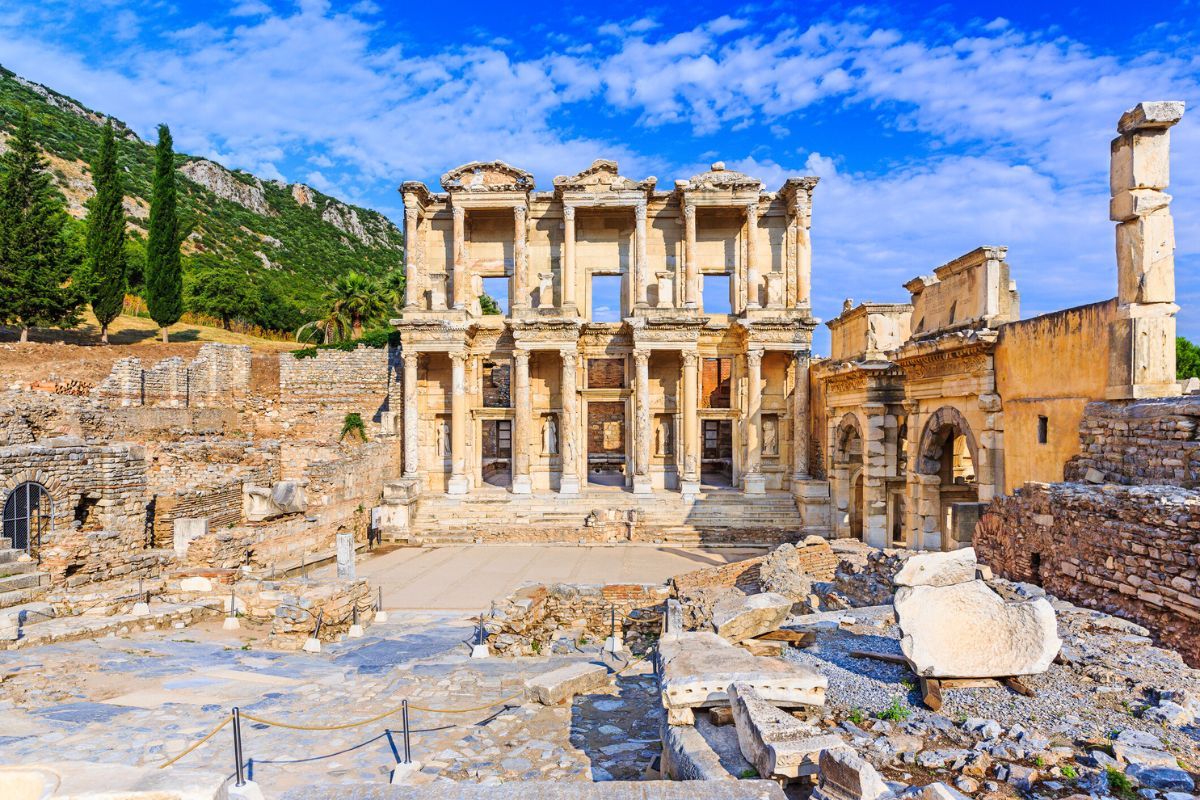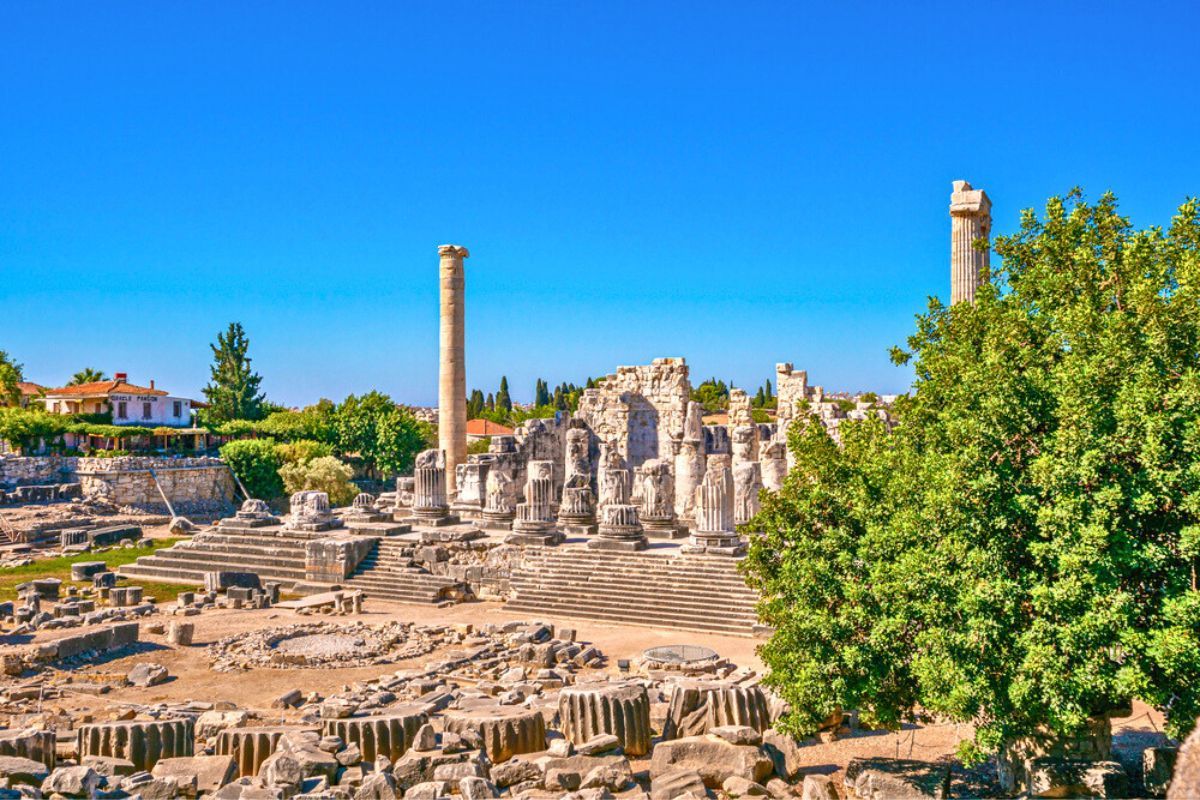Didyma: Day Trips and Tours from Kuşadası
Founded in the 8th century B.C., Didyma is filled with spectacular remains of the ancient world. From intricate sculptures to towering columns, this archaeological wonderland gives visitors an insight into Hellenic architecture and Greek religion.
Didyma day trips from Kuşadası are easy to arrange and enable you to explore many of the ruins that scatter the region. Whether you’re a history buff, a culture lover or a photography enthusiast, you’ll find plenty to keep you captivated in Didyma.
Founded in the 8th century B.C., Didyma is filled with spectacular remains of the ancient world. From intricate sculptures to towering columns, this archaeological wonderland gives visitors an insight into Hellenic architecture and Greek religion.
Didyma day trips from Kuşadası are easy to arrange and enable you to explore many of the ruins that scatter the region. Whether you’re a history buff, a culture lover or a photography enthusiast, you’ll find plenty to keep you captivated in Didyma.

(0/24) checking Musement...
Founded in the 8th century B.C., Didyma is filled with spectacular remains of the ancient world. From intricate sculptures to towering columns, this archaeological wonderland gives visitors an insight into Hellenic architecture and Greek religion.
Didyma day trips from Kuşadası are easy to arrange and enable you to explore many of the ruins that scatter the region. Whether you’re a history buff, a culture lover or a photography enthusiast, you’ll find plenty to keep you captivated in Didyma.

Here's all you need to know about Didyma, one of the most exciting day trips from Kuşadası.
How to get to Didyma from Kuşadası?
The ancient archaeological site of Didyma is located in the modern-day town of Didim on Turkey’s southwest coast. It is approximately 80 kilometers from Kuşadası.
From Kuşadası to Didyma by car
The journey to Didyma takes just over an hour by car and follows the D515 south of Kuşadası. Passing the town of Söke, you’ll merge onto the D525 and follow the road for just over 30 kilometers. You’ll then follow Aydın Didim Yolu all the way to the site.
From Kuşadası to Didyma by bus
Those without access to a car can make the jaunt to Didyma via public transportation instead. You’ll simply head to Kuşadası’s bus station to board a vehicle bound for Didim, which takes just over an hour and leaves several times per day.
Guided tour to Didyma from Kuşadası
Alternatively, you can book a guided excursion to Didyma and allow someone else to organize the transportation details. The majority of these tours last between 6 and 8 hours, however, you can participate in a combination trip that lasts several days. You’ll usually be picked up from your hotel around 9 AM on the day of your excursion.
What is the typical itinerary?

While each Didyma day tour features its own unique itinerary, all excursions share similarities. You’ll benefit from a convenient hotel accommodation pickup service from the lobby of your hotel and, after meeting your guide, you’ll head toward your first destination.
On some day trips, this visiting spot will be Priene, while on others it may be Ephesus. Wherever you find yourself, you’ll be led around the site by your knowledgeable guide who can fill you in on the history and culture behind each monument.
You’ll spend the day hopping between significant destinations, including Miletos, and Didiyma is typically the last stop on the itinerary. It is here that you’ll explore the Temple of Apollo before returning to Kuşadası where your Didyma day trip ends.
What kinds of tours are available to go to Didyma?
There are several different Didyma day trips to choose from, depending on the additional destinations you wish to visit and the amount of time you have to spare.
Day trip to Didyma plus Priene and Miletos from Kuşadası
You’ll begin your Didyma day trip by paying a visit to the ancient city of Priene, founded in the 8th century B.C., where you’ll see a myriad of ruins, including five Ionic columns that surrounded the once-striking Temple of Athena. Continuing on to Miletos, you’ll discover the town’s coin-minting history, as well as its beautifully-preserved horseshoe theater. Finally, you’ll make your way to Didyma where you can wander the remains of the fourth-largest Greek temple ever built, which was visited by Alexander the Great.
Guided tour to Didyma plus Ephesus, Priene and Miletos from Kuşadası
History buffs can instead opt for a Didyma day tour that includes the iconic archaeological site of Ephesus in its itinerary. Here, you can marvel at the colossal Grand Theater, built to hold 25,000 spectators, as well as the Library of Celsus, which was constructed as a funerary monument and once held 12,000 scrolls. After discovering this city, which was founded in the 10th century B.C., you’ll move on to explore the other ancient delights that can be found at Priene, Miletos and of course, Didyma.
3-Day tour to Didyma plus Ephesus, Pamukkale, Priene and Miletos from Kuşadası
If you wish to explore each destination in more detail, consider embarking on a multi-day adventure to Didyma. You’ll spend a day discovering Ephesus and its surrounding landmarks, which include the home it is believed that Mother Mary lived in during the final years of her life, as well as the Temple of Artemis — named one of the Seven Wonders of the Ancient World.
You’ll also have the opportunity to dip into the mineral-rich thermal waters of Pamukkale, as well as the Phrygian city of Hierapolis. Lastly, you’ll spend a day roaming the ruins of Priene, Miletos and Didyma, and learning about both Greek and Roman construction.
How much does a day trip to Didyma from Kuşadası cost?
A basic day trip to Didyma plus Priene and Miletos from Kuşadası costs between US$120, and US$130 per person aged 13 and over. Children under the age of 13 can participate for free and you’ll be part of a small group limited to 14 travelers.
If you choose a Didyma day tour that includes Ephesus, you’ll pay US$300 as a solo traveler of any age. However, you can reduce the cost per head by booking as a group of two or more individuals. You can book for a maximum of 10 guests, and if you have this many people in your party, you’ll each pay US$110.
A 3-day tour is private for your group and costs US$450 per person aged 12, and over. This price includes entrance fees, as well as some meals however, accommodation is at your own expense.
What will you see and do?

The word Didyma translates to “twin” and is in reference to its connection to Miletos through the 17-kilometer path known as the “Sacred Way”. Built in the 8th century B.C., its temple was dedicated to the god of divine distance and was revered by many as it contained one of the most significant oracles of the time.
The site was destroyed in the 5th century B.C. and lay in ruins until it was reconstructed by Alexander the Great approximately 150 years later. The temple was never finished, however, it was planned to be the largest Hellenic place of worship in the world.
Didyma was transformed over the years as it passed through the hands of several different cultures and served as a fortress during the Byzantine period. During the 15th century, it was destroyed by an earthquake, leaving the landmark as it is today.
Visitors on a day trip to Didyma can admire the remains of its 120 columns, alongside the ruins of a multitude of sculptures including several of Medusa — the famed snake-haired Gorgon.
What are the opening times?
Didyma is open daily between 8:30 AM and 7 PM.
When is the best time to visit Didyma?
The best times to visit Didyma are spring (April to June) and autumn (September to November). During these months, the weather is usually nice, temperatures are mild, and there are fewer tourists than in the peak summer season.
Travel tips
- Before visiting Didyma, familiarize yourself with the historical significance of this place. Learn about the ancient Temple of Apollo and its architectural features to fully appreciate its splendor.
- Wear comfortable clothes and shoes as you will be walking and exploring a lot. The ground is uneven, so comfortable shoes are essential.
- The sun can be intense, especially during the summer. Protect yourself from the sun by wearing a hat, sunscreen and sunglasses. Consider bringing an umbrella or seeking shade if needed.
- Didyma is an ancient site and it is important to treat it with respect. Please follow guidelines and restrictions and do not touch or climb the ruins. Also, please help us preserve the ruins for future visitors.
- Plan your visit to Didyma early in the morning or late in the afternoon to avoid the heat and crowds. That way, you can enjoy a more comfortable experience and take better pictures without a lot of people in the background.

